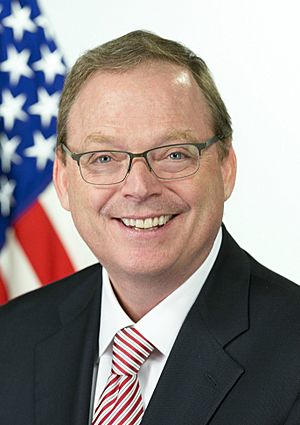Kevin Hassett facts for kids
Quick facts for kids
Kevin Hassett
|
|
|---|---|

Official portrait, 2018
|
|
| Director of the National Economic Council | |
| Assumed office January 20, 2025 |
|
| President | Donald Trump |
| Preceded by | Lael Brainard |
| Senior Advisor to the President for Economic Issues | |
| In office April 15, 2020 – July 1, 2020 |
|
| President | Donald Trump |
| Preceded by | Position established |
| Succeeded by | Position abolished |
| 29th Chair of the Council of Economic Advisers | |
| In office September 13, 2017 – June 28, 2019 |
|
| President | Donald Trump |
| Preceded by | Jason Furman |
| Succeeded by | Tomas J. Philipson (Acting) |
| Personal details | |
| Born |
Kevin Allen Hassett
March 20, 1962 Greenfield, Massachusetts, U.S. |
| Political party | Republican |
| Spouse | Kristie |
| Children | 2 |
| Education | Swarthmore College (BA) University of Pennsylvania (MA, PhD) |
Kevin Allen Hassett (born March 20, 1962) is an American economist. An economist studies how people and countries make choices about money and resources. He became the director of the National Economic Council in January 2025. This council helps the President with economic decisions.
Before this, Hassett was a senior advisor and chairman of the Council of Economic Advisers from 2017 to 2019. He has also worked at the American Enterprise Institute, which is a research group that studies public policy. He advised several presidential campaigns on economic matters.
During the first Trump administration, Hassett led the Council of Economic Advisers. He also returned to the White House in 2020. At that time, he helped the administration with economic plans during the coronavirus pandemic. He focused on how the economy was affected by lockdowns and social distancing.
In November 2024, President Donald Trump announced that Hassett would lead the National Economic Council in his second term.
Contents
Early Life and School
Kevin Hassett grew up in Greenfield, Massachusetts. He went to Greenfield High School. He then studied economics at Swarthmore College, where he earned a bachelor's degree. Later, he received his PhD in economics from the University of Pennsylvania.
Kevin Hassett's Career
Hassett started his career as a professor. He taught economics at Columbia Business School from 1989 to 1994. He also worked as an economist at the Federal Reserve Board of Governors from 1992 to 1997. The Federal Reserve helps manage the U.S. economy. He also advised the United States Treasury Department on policy.
Work at American Enterprise Institute
In 1997, Hassett joined the American Enterprise Institute (AEI). This is a "think tank" where experts research and suggest ideas for public policy. At AEI, he studied topics like taxes, government spending, and energy.
He wrote many articles and papers. These covered subjects such as how taxes affect wages and how companies are taxed. He also wrote columns for major newspapers like The New York Times and The Washington Post.
Dow 36,000 Book
Hassett co-wrote a book called Dow 36,000: The New Strategy for Profiting from the Coming Rise in the Stock Market. It was published in 1999. The book suggested that stock prices would rise much higher.
The book's title referred to the Dow Jones Industrial Average, a stock market index. After the book came out, the stock market did not rise as predicted. Some experts later said the book's ideas were not accurate.
Roles in Trump Administrations
Leading Economic Advisers
In September 2017, Kevin Hassett became the chairman of the White House Council of Economic Advisers. This council gives the President advice on economic policy.
During this time, Hassett discussed how tax laws affect businesses. He also talked about how wages were growing in the U.S. He left this role in June 2019.
Advising During the Pandemic
Hassett returned to the White House in March 2020. He became a senior advisor to President Trump. His job was to advise on economic policy during the COVID-19 pandemic.
He focused on the economic effects of the pandemic. He advised on how to reopen the economy. He left this temporary role in July 2020.
Second Trump Administration Role
After the 2024 election, President Donald Trump chose Hassett for a new role. In January 2025, Hassett became the director of the National Economic Council. This is a very important job where he helps coordinate economic policies across the government.
See Also
- Base erosion and profit shifting

